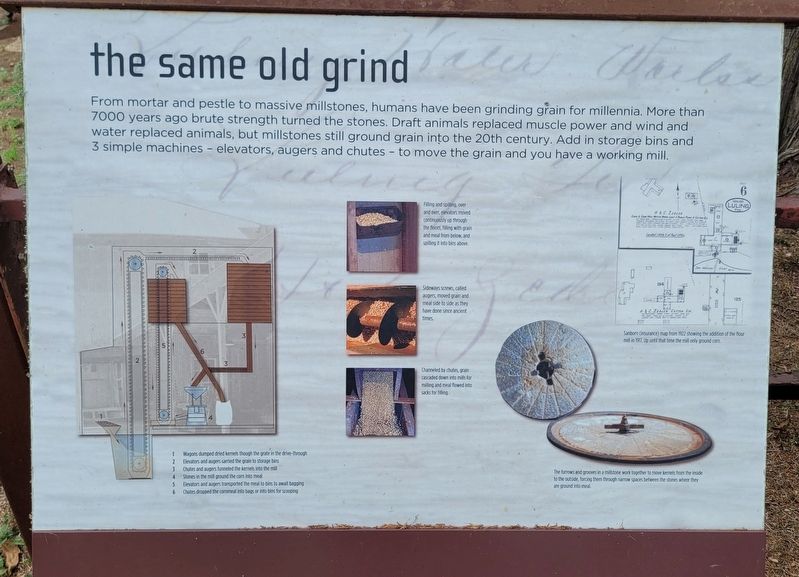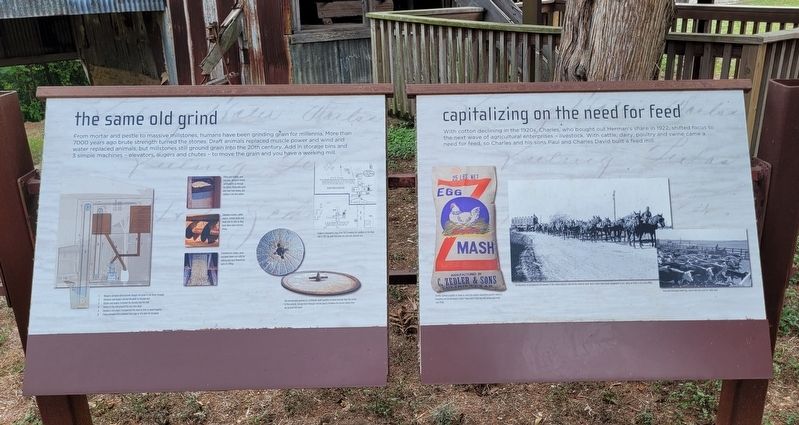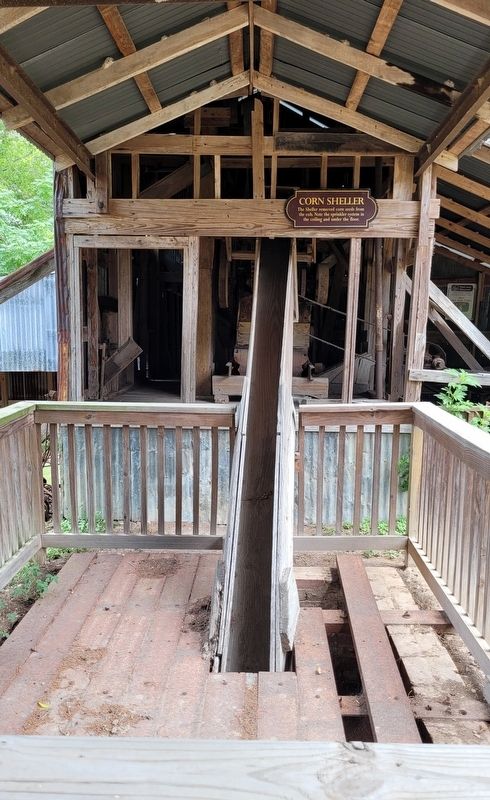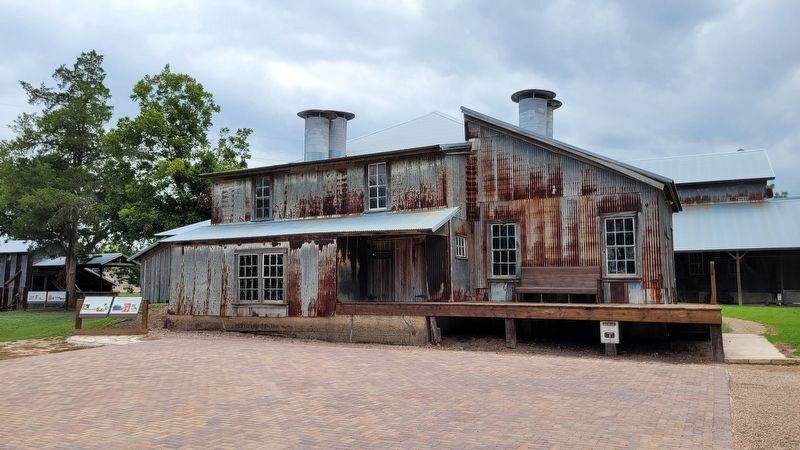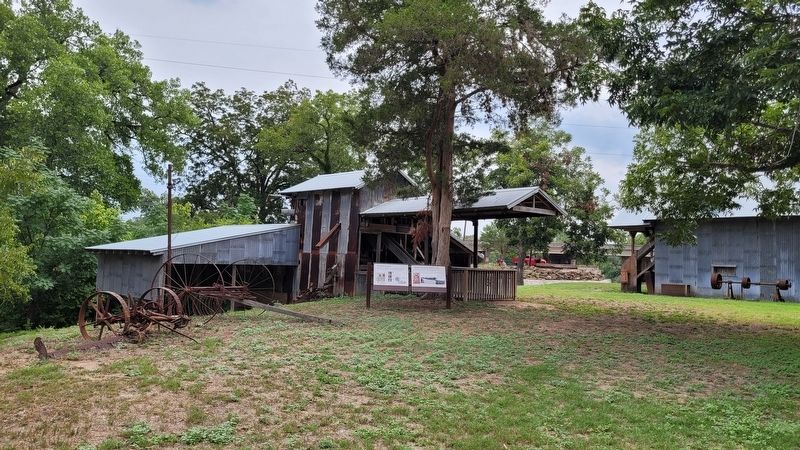Luling in Caldwell County, Texas — The American South (West South Central)
The Same Old Grind
Captions
Lower Left:
1. Wagons dumped dried kernels though the grate in the drive-through
2. Elevators and augers carried the grain to storage bins
3. Chutes and augers funneled the kernels into the mill
4. Stones in the mill ground the corn into meal
5. Elevators and augers transported the meal to bins to await bagging
6. Chutes dropped the cornmeal into bags or into bins for scooping
Upper Middle: Filling and spilling, over and over, elevators moved continuously up through the floors, filling with grain and meal from below, and spilling it into bins above.
Center Middle: Sideways screws, called augers, moved grain and meal side to side as they have done since ancient times.
Lower Middle: Channeled by chutes, grain cascaded down into mills for milling and meal flowed into sacks for filling.
Right Middle: Sanborn (insurance) map from 1922 showing the addition of the flour mill in 1917. Up until that time the mill only ground corn.
Lower Right: The furrows and grooves in a millstone work together to move kernels from the inside to the outside, forcing them through narrow spaces between the stones where they are ground into meal.
Erected by Zedler Mill Museum and Park.
Topics. This historical marker is listed in these topic lists: Agriculture • Industry & Commerce.
Location. 29° 40.03′ N, 97° 39.062′ W. Marker is in Luling, Texas, in Caldwell County. Marker is at the intersection of South Laurel Avenue and South Magnolia Street (State Highway 80) on South Laurel Avenue. The marker is located in the central section of the Historic Zedler Mill Museum and Park. Touch for map. Marker is at or near this postal address: 1170 South Laurel Avenue, Luling TX 78648, United States of America. Touch for directions.
Other nearby markers. At least 8 other markers are within walking distance of this marker. Capitalizing on the Need for Feed (here, next to this marker); Responding to a Looming Need (a few steps from this marker); Going with the Grain (a few steps from this marker); Using Your 'Head' (within shouting distance of this marker); From Spin to Gin (within
shouting distance of this marker); From Boll to Bolt (within shouting distance of this marker); Mixing to Match (within shouting distance of this marker); Zedler's Mills (within shouting distance of this marker). Touch for a list and map of all markers in Luling.
More about this marker. The Zedler Mill Park and its parking are free to the public daily. Donations are appreciated when visiting the Zedler Mill Museum.
Also see . . .
1. Zedler Mill Museum & Park. The City of Luling, Texas
In 1885, Bob Innes, John Orchard, J.K. Walker, and a German immigrant mill expert named Fritz Zedler, purchased the site and mill equipment naming it the "Luling Water Power Company". Soon they added a lumber sawmill and Fritz Zedler replaced the existing stone dam with a wooden dam and penstock that could generate more power. Buying out his three partners within a few years, Fritz Zedler became sole owner in 1888 and invited his oldest son, Berthold, to be his partner. Not long after the acquisition, the entire three story facility caught fire in October 1888 and was totally destroyed. The citizens of Luling promised to hold the sale of their cotton crops for the Zedlers to rebuild. Devastated, but not giving up, the Zedler family rebuilt the mill factory and within seven weeks, it was operational.(Submitted on September 1, 2022, by James Hulse of Medina, Texas.)
2. Milling. Texas State Historical Association
Flour and grist milling was the first-ranking Texas industry until after the Civil War, and hundreds of mills of various capacities were scattered throughout the state. The old burr mill was gradually superseded by roller mills. In 1880 flouring, as it came to be called, and gristmill products again held first rank by value over all other Texas manufactured products. In 1890 flouring and gristmill products had dropped to second place, and in 1900 to third. From 1910 to 1940 they consistently held fourth place, while both quantity and value of the products increased with the introduction of modern methods and equipment. The total value of the products of sixty-seven mills in 1940 was more than $12 million. By 1950 the Texas milling industry was conducted largely by big corporations, and custom milling had become a thing of the past.(Submitted on September 1, 2022, by James Hulse of Medina, Texas.)
Credits. This page was last revised on September 1, 2022. It was originally submitted on September 1, 2022, by James Hulse of Medina, Texas. This page has been viewed 65 times since then and 5 times this year. Photos: 1, 2, 3, 4, 5. submitted on September 1, 2022, by James Hulse of Medina, Texas.
